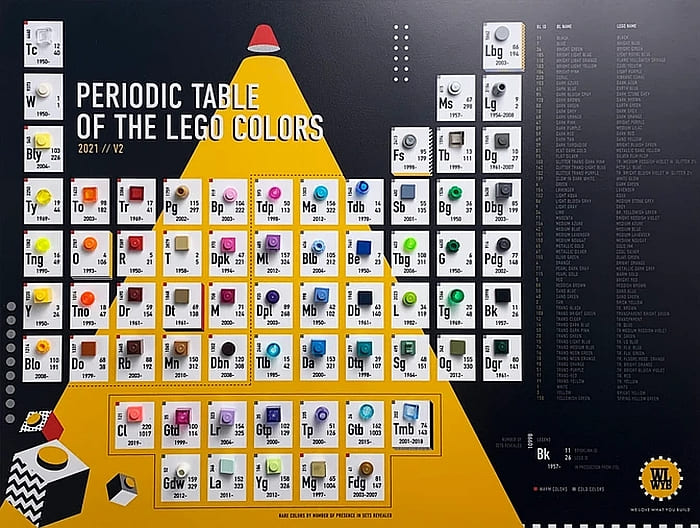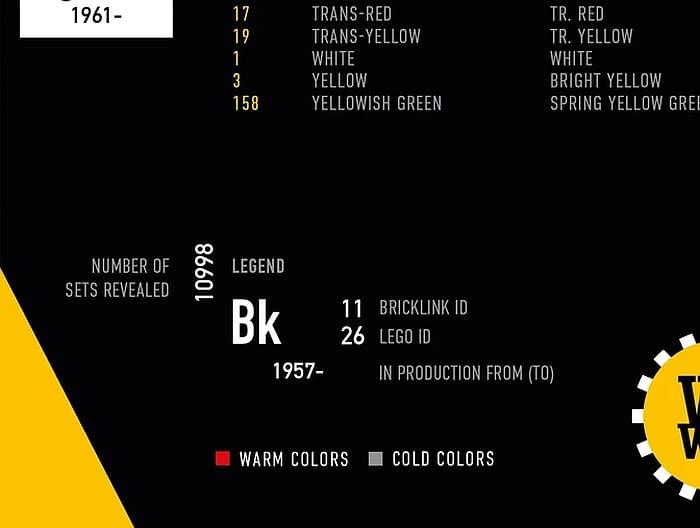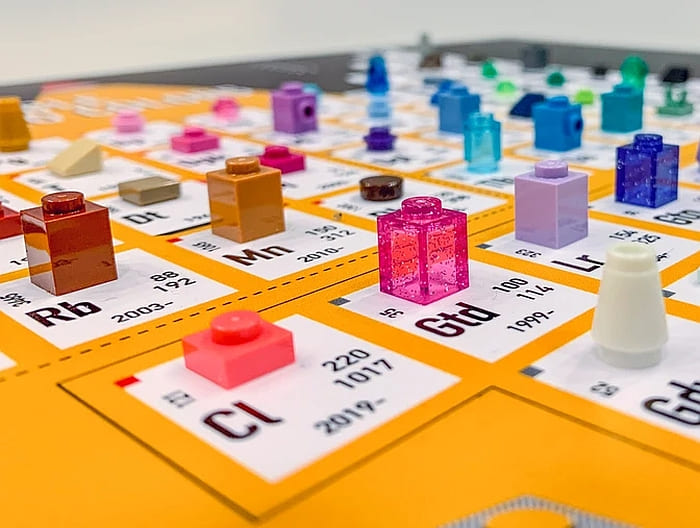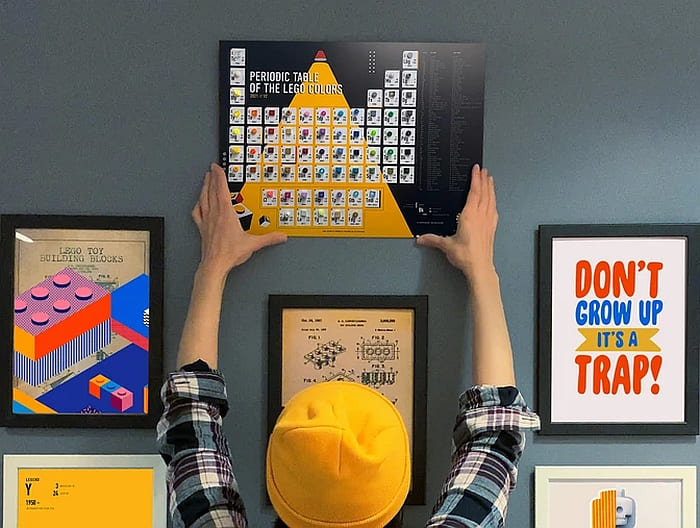You might remember that a few months ago we talked about an interesting product called the First Periodic Table of LEGO Colors. LEGO fans are often confused about the names and availability of LEGO colors, especially the rare and unusual ones. Correctly identifying LEGO colors can also be a challenge for those who buy and sell LEGO online.

The First Periodic Table of LEGO Colors was a big hit with LEGO fans looking for an accurate color reference, and it was also popular with those who just wanted a unique decoration for their LEGO room. The online store offering the periodic table is called WLWYB.com (short for We Love What You Build), and they recently released an updated version of the product called, The Periodic Table of LEGO Colors V2.0.

In the second version of the periodic table, the colors are arranged in a bit more logical manner than in the first version. A dividing (dotted) line splits the main section into warm and cold tones, which helps with quickly finding the color you’re looking for. And there is also a separate section for rare colors. (In the previous version, this separate section featured all the transparent colors.) In addition, the blue/yellow background was changed to black/yellow to better highlight the colorful pieces.

The Periodic Table of LEGO Colors V2.0 features real LEGO pieces in 65 different colors and 12 different shapes. Every box tells you the official LEGO names and BrickLink IDs of the colors, as well as the year of manufacture. A new feature for the second version is the addition of how many sets the color appeared in.

The overall size of the periodic table from version one to version two didn’t change. It’s still 15.7 x 11.8 x 0.6 in / 40 x 30 x 1.5 cm, printed on a high quality foam board with vibrant colors. You could potentially just attach it to a wall with thumbtacks or double-sided tape, but frankly, it’s so nice, you probably want to frame it.

The price also didn’t change. It’s still $39.95, which includes free worldwide shipping. This is a very reasonable price for what you get. In addition, the store is currently offering 10% off to our readers. (They reached out to me and thanked me for featuring their product previously and to offer a discount.) If you are interested to get your own Periodic Table of LEGO Colors, visit WLWYB-Shop.com and use the code TBB10 at checkout. This offer is valid until February 25th.

I know the struggle of identifying LEGO colors as I have been building my own LEGO models and using BrickLink for many years. In fact, I have my own LEGO color chart that I built up through the years using 2×2 bricks with a piece of paper stuck to the top to identify their names. I have also seen people attempting to create a color chart by adding all important information about each color and trying to print exact LEGO colors on paper. The Periodic Table of LEGO Colors solves a lot of the problems by having relevant information printed on the chart but using real LEGO elements to demonstrate the colors.

I suppose the issue is going to be to keep the information of the periodic table updated as LEGO adds new colors while retiring others. But as a good general guide, both the first and second version of the Periodic Table of LEGO Colors should remain a handy tool LEGO designers and everyday builders could refer to for several years. Again, if you want to get your own, visit WLWYB-Shop.com and use the code TBB10 at checkout by February 25th.

What do you think? How do you like the updated version of the Periodic Table of LEGO Colors? Do you find it useful for your own LEGO sorting, storing, and shopping? Feel free to share your thoughts and discuss in the comment section below!
And you might also like to check out the following related post:
- The First Periodic Table of LEGO Colors (original version)












I like the idea of a chart like this, but what’s the point of putting them in the format of a periodic table? Wouldn’t it make more sense to separate them by color type or something like that?
It’s just a gimmick. The sorting has been criticized for not making much sense, anyway. It’s not periodic in a traditional sense..
The previous version had five more colors. What did they take off? And why?
Someone at Brickset worked it out:
Colors that V2 has that V1 doesn’t:
Trans Neon Orange; Bright Light Yellow (Cool Yellow); Flat Dark Gold (Metallic Sand Yellow)
Colors that V1 had that V2 doesn’t:
Blue Violet (Med. Bluish Violet); Brown (Earth Orange); Glitter Trans Neon Green; Light Nougat; Maersk Blue (Pastel Blue); Medium Orange (Br. Yellowish Orange); Pearl Light Grey (Silver); Very Light Grey (Light Grey)
I guess the answer to ‘why’ is that several of these rarer colors would have become too unfeasibly expensive to warrant their place in the table.
It seems to have all the modern colors and a few of the retired ones. Works for me, but not for color collectors or Lego historians.
I have V1, and I love it! It is especially handy for the blues (I struggle with the difference between Maersk, med blue, and azure – oy!). I framed mine since I have a cat who is a LEGO thief, and I mounted it to the wall in my KEGO room. It is well worth the price, IMO.
Su, thanks for sharing. Yeah, blues are some of the most challenging colors to identify, as there are so many of them! 🙂
I’m always confused by the greens and the blues, so this is going to be immensely helpful.
I could definitely use this. Having examples of the colors helps planning mocs. I know I can look them up online, but it’s not the same as real examples. I’m just wondering how are they going to keep up with new colors.